When mentioning Quang Binh, many people often think immediately Magnificent cave system in Phong Nha – Ke Bang, or the endless beach in Dong Hoi. However, few people know that Quang Trach – a land not far from those points, has unique historical and cultural values, and is also one of the attractive places for tourists in Quang Binh.
Although located on the plain, Quang Trach has diverse and attractive natural beauty. Not only possessing beautiful sea landscapes, this place also has historical and cultural relics such as Vung Chua-Dao Yen area, Hoanh Son Quan, and Lieu Hanh Holy Mother Temple. Thanks to that, Quang Trach is a favorable place to develop forms of ecological, cultural and spiritual tourism. At the same time, traditional craft villages and unique cuisine also bring character and attraction to tourists.
Vung Chua – Yen Island
Vung Chua – Yen Islandis one of the prominent destinations in Quang Trach province, famous for its wild and majestic natural beauty. This is not only an interesting tourist destination but also has special spiritual and historical value. Located in Tho Son village, Quang Dong commune, Quang Trach district, Vung Chua – Yen Island is located right at the foot of Ngang Pass, about 64 km north of Dong Hoi city. Local people have long told each other about this special land, they often call this place “the land where the dragon curls up and the tiger sits”. The outstanding feature of the terrain here is the shape of a giant fan, surrounded by three small islands including Hon Nom, Hon Gio and Hon La, creating a harmonious picture between limestone mountains and blue sea. Vung Chua – Yen Island carries important historical values, becoming the final resting place of General Vo Nguyen Giap and showing respect and gratitude to the great man of the nation.
Vung Chua – Yen Island in Quang Binh is a destination that makes people feel surprised by its wild beauty and peaceful, comfortable atmosphere. The name “Vung Chua” is understood in two aspects: “Vung” means peaceful sea, and “Pagoda” means a sacred ancient temple from hundreds of years ago. Although the pagoda no longer exists, only the foundation remains, the name “Vung Chua – Yen Island” is still maintained today. One of the most notable spots in Vung Chua – Yen Island is Hon La beach. In the book Dai Nam Thong Chi, this place is recorded as a place to exploit rare products to serve kings during feudal times: precious seafood dishes such as bird’s nest, blood cockles, lobsters and abalone. Tourists also cannot miss conquering Tho Mountain, an interesting and attractive place. Tho Mountain is shaped like a bow connected to Dragon Cape, facing straight to the wide sea. At the foot of the mountain, the vast white sand beach stretches, surrounded by lush greenery.
The best time to visit Vung Chua – Yen Island is during the summer, from April to September, when the weather is nice and the sea is clear. To get here, visitors can choose motorbike, bus or train, depending on personal preferences and needs. Vung Chua – Yen Island is suitable for all audiences, from the elderly to children and young people. However, visitors need to remember to wear sunscreen, comfortable shoes and comply with the resort’s regulations to ensure safety.

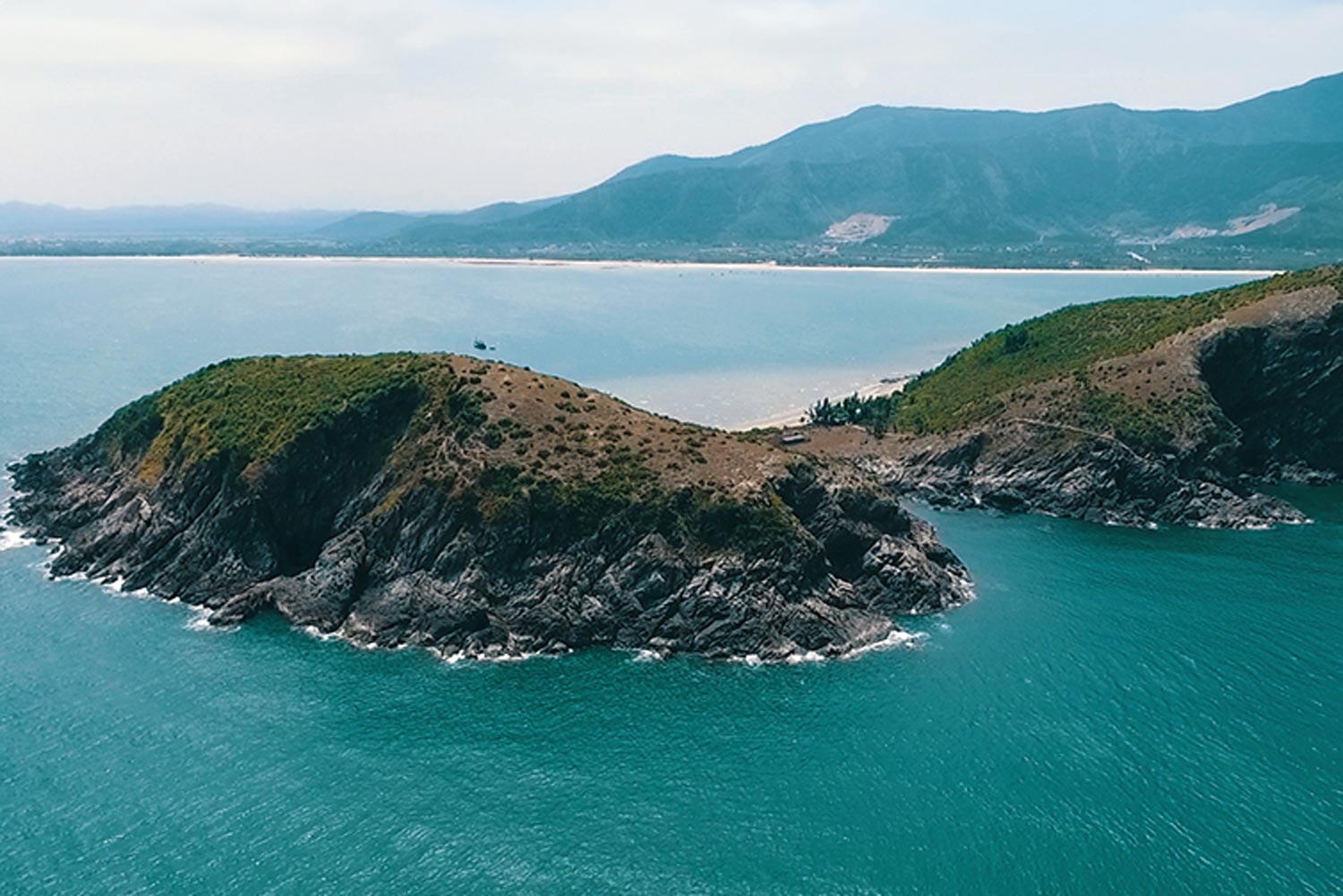
Temple of Holy Mother Lieu Hanh
Temple of Princess Lieu Hanhis a special point in the list of spiritual tourist destinations in Quang Trach. Located at Ngang Pass, Quang Dong commune, Quang Trach district, Quang Binh province, Lieu Hanh Temple is an important cultural and religious symbol. From Dong Hoi city center, you need to travel 65km to reach this location.
With an area of nearly 350 m², the temple worshiping Mother Goddess Lieu Hanh stands right at Ngang Pass, facing the sea in front and surrounded by the Hoanh Son mountain range behind. The space around the temple represents a wonderful harmony between nature and spirituality. The tradition of worshiping Mother Goddess Lieu Hanh is an important part of folk beliefs. Princess Lieu Hanh is honored as one of the four immortals, and this temple was built to express respect and worship to her. Legend tells of Princess Quynh Hoa, daughter of the Jade Emperor, who was punished and exiled to the lower world. However, during her days in the human world, she spent her whole life helping people and accumulating good merits. Thanks to her compassion and love, she was worshiped and respected by the people.
Vietnamese people often view Princess Lieu Hanh as a Mother Goddess in spiritual life. She is one of the four immortal saints, representing the good qualities of Vietnamese people. Every year, the death anniversary festival of Saint Mother Lieu Hanh takes place from 1 to 3 of the third lunar month, attracting a large number of people and tourists to participate. The festival includes traditional rituals, prayers and spiritual activities honoring Princess Lieu Hanh. Tourists often come here to pray, asking for peace and luck for their families and relatives. The peaceful and sacred space of Lieu Hanh Mother Temple is the ideal place to find serenity and peace of mind.
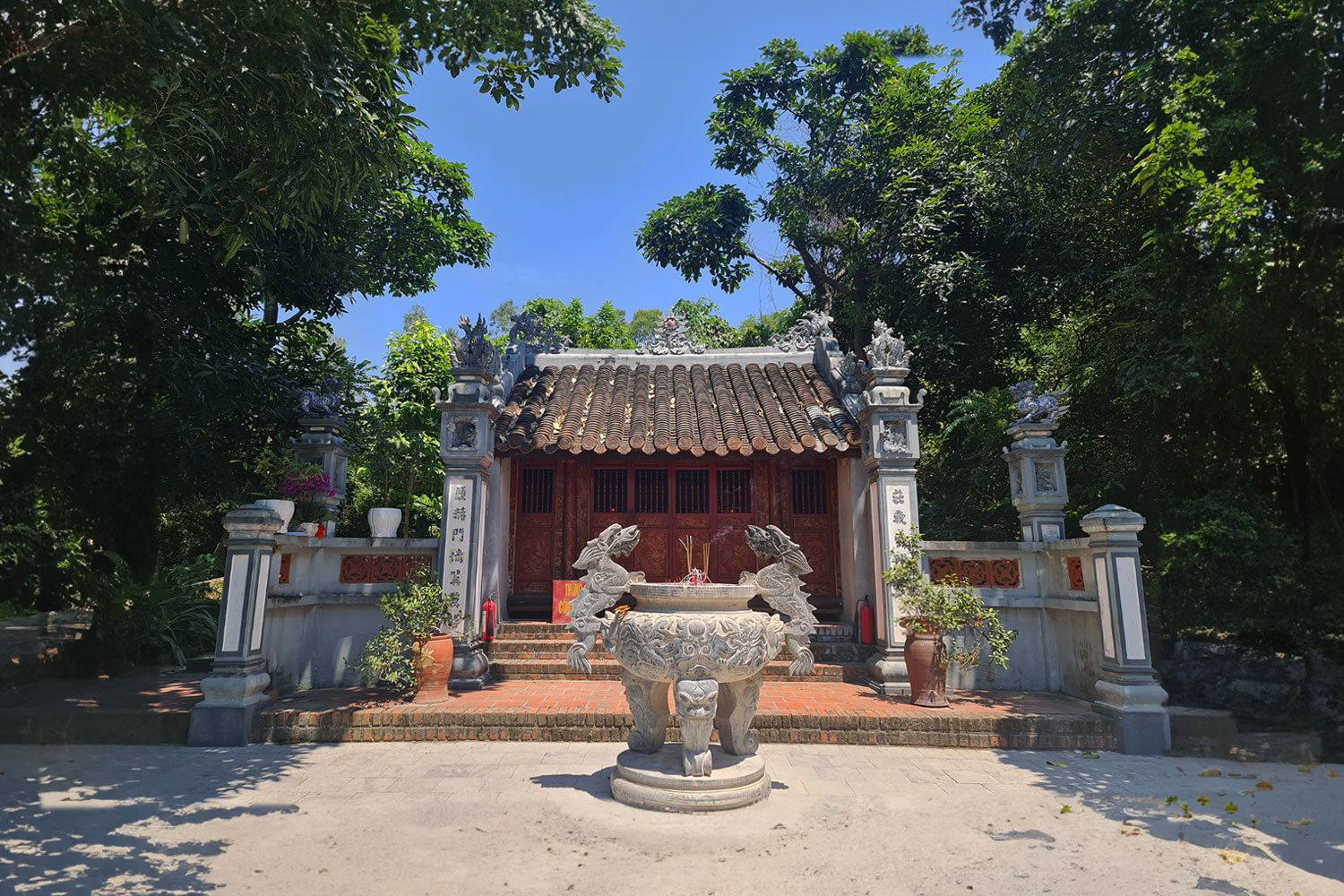
Tan An rice paper village
Tan An rice paper village, located in Quang Thanh commune, Quang Trach district, Quang Binh, has kept a development history of more than 100 years. With peaceful landscape and delicious, crispy rice paper flavor, Tan An rice paper village has become an attractive traditional tourist destination in Quang Trach.
This place is famous for two types of quality rice paper: black sesame/red sesame rice paper and white “rubbed sesame” cake used to make spring rolls or ram (spring rolls). The process of producing rice paper in Tan An village requires skill and technique. By combining the main ingredients rice flour and water, they create thin, smooth, and attractively colored rice paper sheets. In the sunlight, the cakes spread out on the roads and alleys, creating a bright picture under the beautiful picture of nature.
Tan An rice paper village not only brings food and clothing to the people but also contributes to local economic development. More than 200 households participate in rice paper production, creating a famous brand with diversity in making and flavor. Tan An rice paper products have been OCOP certified and are widely available in markets, supermarkets and restaurants.
Although it has contributed to changing the face of the countryside and nurturing many generations, Tan An rice paper village still faces many challenges. Factors such as weather, environmental conditions and market variations affect production and consumption. However, during times like Lunar New Year, Tan An rice paper village becomes even more vibrant. At this time, the village gathers more than 100 workers to meet the demand for high-end shopping at the end of the year. With the desire to preserve and develop the brand, Tan An rice paper village has been creating opportunities for people to participate in the production process. Although still facing many difficulties, the perseverance and passion of the people have helped maintain the traditional profession and bring the unique flavor of Tan An rice paper village to the next generation.
When arriving at Tan An rice paper village, visitors will have the opportunity to enjoy delicious rice paper sheets and have many interesting activities to experience. First, visitors can visit the rice paper production process at baking facilities. The experience of preparing ingredients, mixing dough, pouring cakes and baking cakes will help you better understand the traditional cake production process.
Exploring the peaceful space of rice paper village is an interesting experience. Walking in small alleys, admiring the long rows of rice paper, and participating in the daily lives of people is a good way for you to better understand local culture and life. If you want to contribute to supporting the community, shop for rice paper and local handicraft products, so you will have the opportunity to enjoy the unique flavor of Tan An rice paper and experience the culture and history. history and life of the people in this traditional craft village.

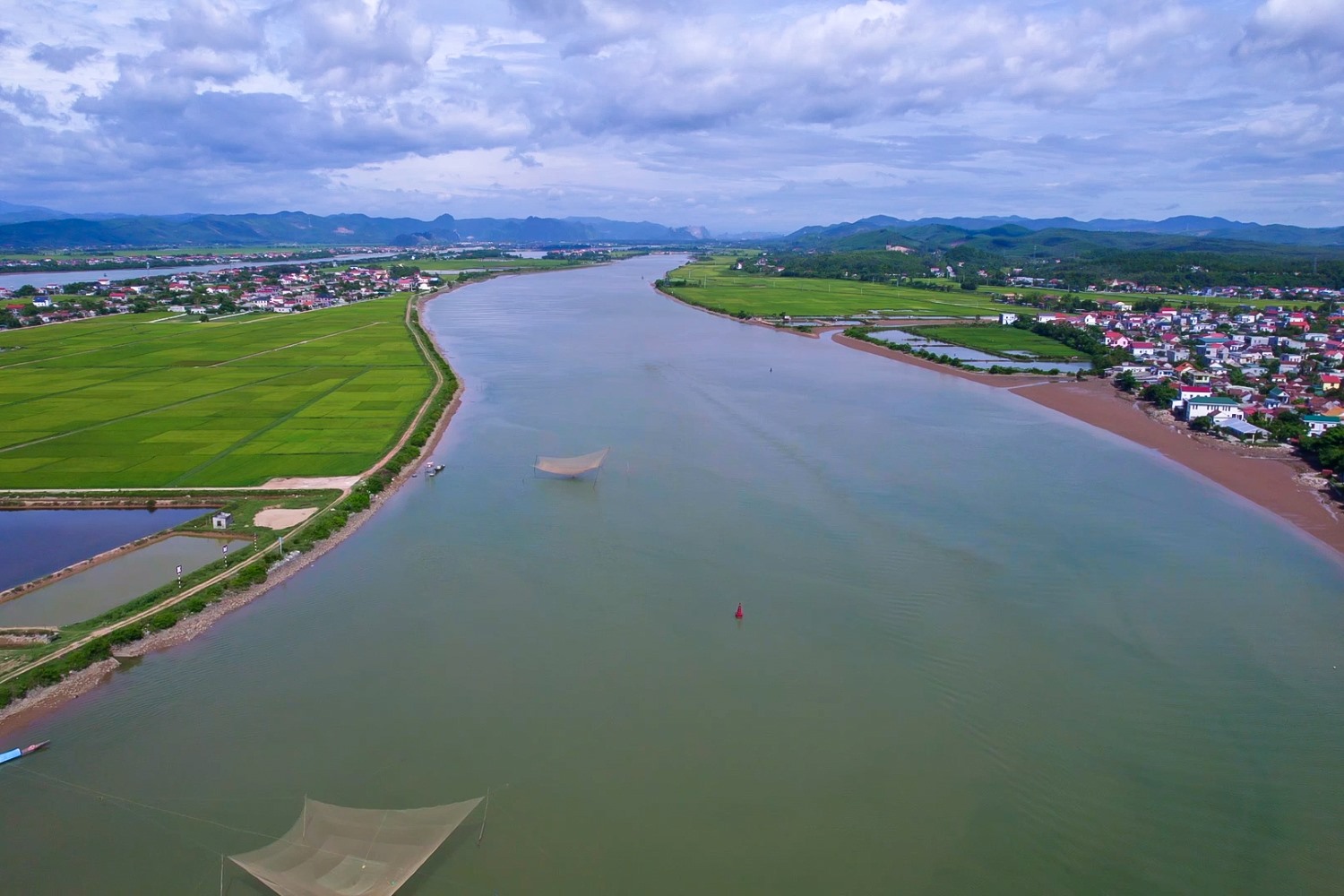
Tam Level Waterfall
Located in Quang Kim commune, Quang Trach district and about 60km from Dong Hoi city center, Tam Cap Waterfall is waiting for tourists who are fascinated with its pristine nature and beautiful waterfalls. With its pristine beauty and vast space covered with forest canopy, this is a place not to be missed for those who love travel experiences.
When you set foot at Tam Cap Waterfall, you will be fascinated by the majestic natural beauty of the Western Hoanh Son region. The cool blue water from the source of Hoanh Mountain creates a 3-level waterfall like a forever woven silk strip, with vast mountains and forests on both sides, and the sounds of the mountains and forests combined with the sound of flowing water and birdsong create an atmosphere. peaceful.
At Tam Cap Waterfall, you also have the opportunity to admire Cao Cac Mac Son Temple, a place to worship martial generals who explored the Tay Hoanh Son region hundreds of years ago. The temple was built along the Vuc Tron reservoir, giving visitors a charming landscape of the river. From above, the water flows down to the foot of the mountain creating a feeling of relaxation and freedom. However, because of its wild beauty, traveling here requires good health and careful preparation.
The dry season is a great time to explore Tam Level Waterfall. The cool, clear water, the sound of the waterfall and the chirping of birds create a feeling of relaxation and peace. During this season, you can soak in the cool water at Tam Cap stream, watching the waterfall falling from the majestic forest canopy. In addition, you also have the opportunity to enjoy food prepared on the spot and travel experiences that are not available everywhere.
Tam Cap Waterfall is not only an attractive tourist destination in Quang Trach but also contributes to the local community. With the ability to provide clean water to thousands of households and people, Tam Cap Waterfall has become a source of life and hope for the sustainable development of the region.
Tam Cap Waterfall is a wonderful crystallization of nature and history, bringing visitors into a wild, peaceful and fascinating world. Coming here, you will feel the strong connection between people and nature, along with a lesson about respecting and protecting precious resources.
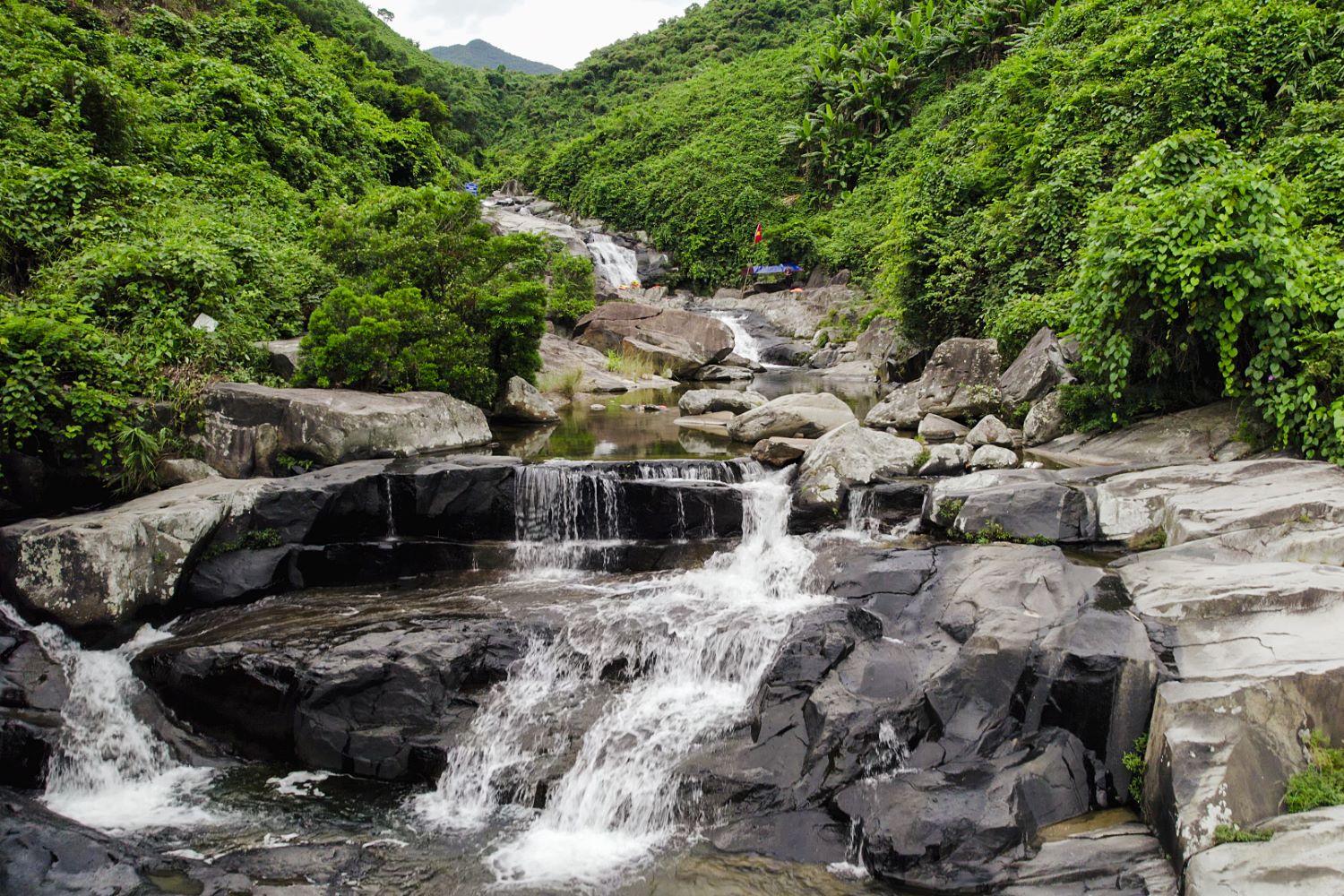
Heaven Gate Hoanh Son Quan
From Dong Hoi city, traveling along Highway 1A north about 67km will take you to a special point – Ngang Pass. Here, the Truong Son mountain range rises like a blade reaching out to the sea, creating a beautiful mountainous area with perfect natural scenery. About 6.5km long, this road curves along the Truong Son mountain range, connecting Quang Dong commune (Quang Trach) with Ky Nam commune (Ky Anh, Ha Tinh). Although there is now a road tunnel, Ngang Pass still attracts tourists because of its wild natural beauty.
From the top of the pass, a natural picture stretches before your eyes. To the east, the East Sea stands out with Yen Island and Hon La Island creating smooth white sand beaches. To the south, houses, streams and rice fields meander along the stream creating a peaceful image of life along the pass. At the top of Ngang Pass, you can see a board dividing the border between Quang Binh and Ha Tinh provinces. Turning along a small road on the right side of the mountain, you will come to Hoanh Son Quan – a historical site of special significance.
Hoanh Son Quan, also known as Heaven’s Gate, is an important gate on the heavenly road connecting Dai Viet and Champa in the past. Built during the reign of King Minh Mang in 1833, this structure is more than 4 meters high and has two stone foundations running up the mountain and down to the sea. Previously, this gate had thousands of stone steps so passersby could go up and down the mountainside. Currently, the south gate has lost its stone steps, the north gate only has a few hundred steps left. Standing on top of Hoanh Son Quan, you can look out to the west at a green mountain range with clouds flying idly in the air. To the south, you will see a mountain range hundreds of meters high, creating a green wall. From the top of Ngang Pass, you can see the entire land of Ky Anh town, Ha Tinh province, spreading out like a mesmerizing watercolor painting.
Hoanh Son Quan has gone through the hardships of time and human impact. Although still intact with a structure over 4 meters high and two stone foundations, this work has been damaged by engravings of writing, signatures and drawings on the back. Although the ancient beauty of Hoanh Son Quan still remains, with the development of road tunnels, this relic is gradually forgotten.
To get to Hoanh Son Quan, you can choose to go by motorbike, private car or rent a bus. The journey from Dong Hoi city along National Highway 1A towards Ngang Pass is about 100km. This pass area has dangerous terrain, so you should choose a safe vehicle to ensure the safety of the trip. Enjoy an exciting journey and immerse yourself in the majestic scenery of Hoanh Son Quan at the top of Ngang Pass, which at the same time awakens reflections on the history and natural beauty of this land.
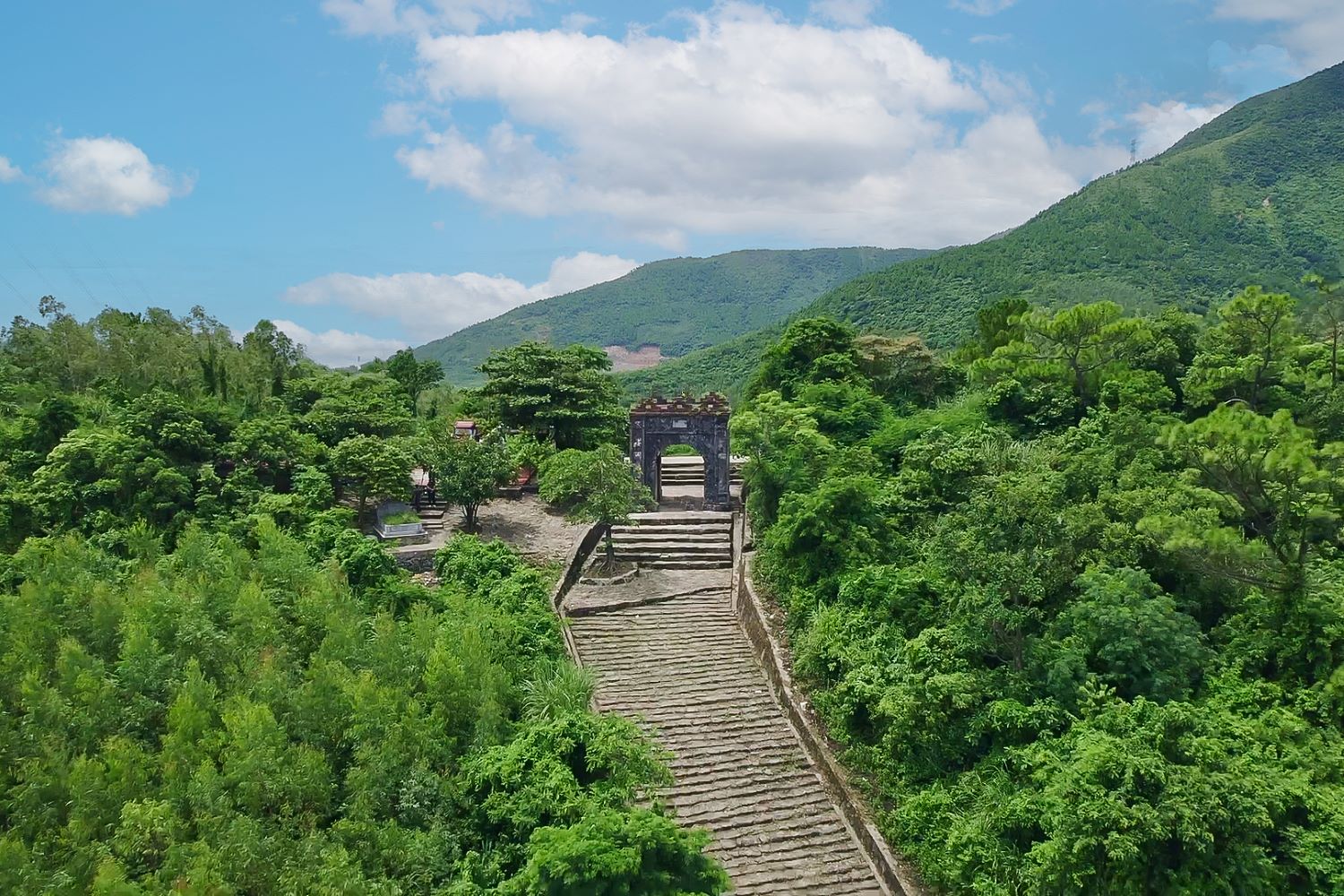
500 year old brooch forest in Quang Xuan
In the sandy, sun-burnt land of Quang Binh province, an ancient Bamboo forest with an area of more than 150 hectares hidden in Thanh Binh village, Quang Xuan commune, Quang Trach district, has existed as a witness. live about the diversity and persistence of nature in Central Vietnam.
The base of the Bamboo tree in Thanh Binh village has a common diameter of 20-30 cm, creating a unique landscape with rough, perennial trunks covered in bright green. From above, the forest creates a cool green patch, like a blanket covering the white sand dunes below. In summer, the forest of Bamboo gourd begins to flower, and at the end of the year, small fruits grow from the top of the tree with a sweet flavor combined with a slightly astringent aroma. Spring awakens young shoots to grow, creating a chain of eternal life. The interesting thing is that the gourd plant can only germinate on its own and cannot be grown from seeds or seedlings, which is a symbol of majestic nature.
The Bamboo Forest not only brings natural beauty but is also a home for many species of birds and other animals. With dense vegetation, many bird species such as starlings, combs, cuckoos and falcons have found a safe place to nest and breed. In particular, forests also provide a suitable environment for many species of reptiles and amphibians, contributing to the biodiversity of this land.
However, the value of the brooch forest does not stop at the natural aspect. In the past, during the resistance war against the invasion of foreign invaders, the forest became a refuge for guerrilla groups and also an important shield against enemy attacks. . This contributed to the pride and heroic resistance of the nation.
Thanh Binh Village has built a forest protection team since 1959, the team included 11 original members. Members of this team both take on the role of protecting the forest from activities that violate the environment, and ensure compliance with rules and regulations to protect the forest. Their remuneration is paid in rice from the agricultural cooperative.

The system of rules and regulations on protecting Bamboo forest has become an important part of the culture and soul of Thanh Binh people. Since ancient times, the elderly have taught their children and grandchildren about the importance of the forest as a precious source of life. This model has been passed down from generation to generation, and has created respect and dedication to protecting and maintaining the forest. Thanks to the efforts of the Thanh Binh community in protecting, maintaining and respecting the Bauhinia forest, this forest has existed and developed for many generations.
Mural of Canh Duong coastal village
Located about 57km from Dong Hoi city center,Canh Duong Mural Village, Quang Binhfamous as an interesting destination for tourists, especially young people, to explore and preserve beautiful moments by the sea. To get to Canh Duong Mural Village, you will need to follow Highway 1A north from the city center, and at the foot of Roon Bridge, you will turn right to enter the bright and fertile world of this coastal village.
Canh Duong Mural Village is filled with the colors of Phuong Mountain and Loan River, creating a picture of harmony between nature and people. This is also one of the “eight famous incense sticks”, i.e. 8 ancient villages with longstanding reputation in Quang Binh. This village was once a splendid dressing table during the war against the French invasion. During that period, Canh Duong turned his homeland into a proud resistance flag, resisting more than 120 large and small raids, including 4 large-scale raids. This is associated with the name and indomitable spirit of the people of Canh Duong.
The popularity of Canh Duong Mural Village comes not only from its great past but also from the creative spirit and passion of a group of young people. This special achievement is demonstrated through the “Future Mural” project, a project led by artist and architect Nguyen Viet Dung (born in 1984). With the desire to help the local community develop Quang Trach tourism and create unique artistic value, this group of young people created impressive mural works. These paintings have been sourced from documents from Canh Duong Village Traditional House and photos from photographers, but are also designed in 3D to create vivid works of art on house walls and fences.
Canh Duong Mural Village in Quang Binh is both a unique artistic and cultural attraction and a proud symbol of the people here for the beautiful 3D paintings in their beloved homeland. The village’s characteristic is a nearly 1 kilometer long road on which up to 50 colorful and lively 3D murals are arranged.
Along the fishing village road, each painting simulates a different scene or situation, providing a unique perspective on life in wartime and peacetime. Every painting is presented with meticulousness and dedication to every detail, which is why each painting becomes a unique work of art, depicting a part of everyday life with simplicity and moss. ancient.
These paintings also contain touching and meaningful stories. From images of daily life to heroic moments during wartime, from the beauty of the natural environment to scenes of the solidarity of people in fishing villages, all are faithfully recreated. Realistic and full of emotions in each painting. At the same time, it is also a symbol of the pride and love of the homeland of the people here. They constantly contribute and share the cultural, historical and artistic values of the fishing village with tourists, contributing to making Canh Duong Mural Village an attractive and memorable destination in the journey to explore the region. Quang Binh land.
The best time to enjoy the village’s beauty is from March to September, when the weather is usually relatively favorable and sunlight highlights the frescoes. You can spend time immersing yourself in this art space in the early morning (from 8 – 10 am) or late afternoon (from 4 – 6 am), when the soft and shifting light of the sun creates a frame. gorgeous picture.
Like every outdoor tourist destination, when coming to Canh Duong Bich Hoa Village, you should prepare ao dai and a hat to protect yourself from the sun. Tourism in the village takes place outdoors, so bringing appropriate clothing will help you enjoy the journey comfortably and safely.
When entering Canh Duong Mural Village in Quang Binh, you will visit many other unique places such as the Ancestral Temple, Linh Ngu Temple, an ancient house and a discreet moss-covered coral wall. Prepare yourself for an exciting journey and enjoy the beauty of Canh Duong Mural Village, which evokes memories of the blue sea and the indomitable spirit of the local people.

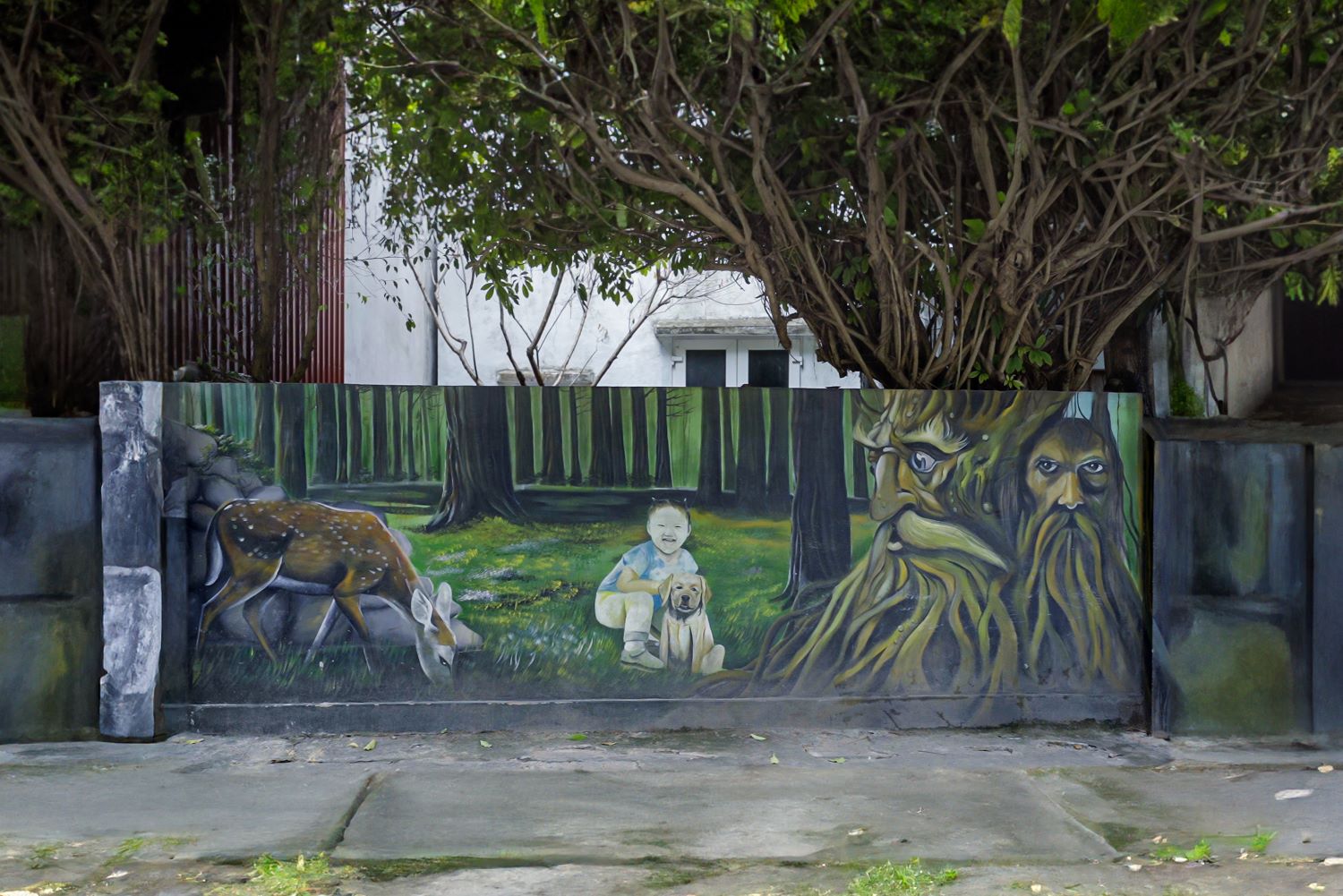
Canh Duong beach village
Canh Duong fishing village is nestled in the coastal area of Canh Duong commune, Quang Trach district, Quang Binh province, Central Vietnam. This is not only an idyllic village with blue sea scenery, white sand, and traditional wooden houses, but also a symbol of life connected to the sea and rich cultural values.
Canh Duong fishing village was founded in 1634, and has now experienced more than 380 years of history. The people in the village originate from neighboring areas such as Nghe An and Thanh Hoa, and since coming here, they have been closely associated with fishing and the sea. Their lives rely on the landing of seafood from the sea every day, creating a daily life cycle with the magic of the sea.
The new day in Canh Duong often starts early, when the fishing boats return from night diving bringing back fresh seafood. Canh Duong fish market on the harbor is always bustling, with colors, flavors and laughter of buyers and sellers. Fresh fish, squid, scallops, and other seafood are waiting to be carried around. In addition to fishing, fish sauce making is also an important part of life in Canh Duong. The tradition of making fish sauce here is both a daily job and a delicate art. The famous fish sauce from ancient times is Ham Huong fish sauce, made from a rare type of transparent pink fish. To make Ham Huong fish sauce, people have to go through many elaborate and delicate steps.
Quang Binh Cau Ngu Festival is an important cultural event of Canh Duong people. Taking place on the 15th day of the first lunar month every year, this festival combines worship of the Fish God and an opportunity for the community to gather, express gratitude and joy for marine life.
The ritual part of the festival includes offering incense and reading the Than Ngu eulogy. This is the time when people honor and pray for the protection and support of the God of Fisheries during sea voyages. This belief reflects the deep relationship between people and the sea, when fishermen believe that the God of Fisheries will protect them in the face of storms at sea. In addition to beliefs, the festival also includes folk singing and dancing activities and traditional performances such as “cotton rowing dance”, which showcases the culture and artistic talents of Canh Duong people, and is a way to recreate marine life and fishing.
Canh Duong fishing village is not only a place with a vibrant fishing life but also a symbol of the spirit of interaction between people and the sea. Cau Ngu Festival, along with fish sauce making and daily life, has created a unique cultural heritage, demonstrating deep respect and interaction between humans and nature. Every year, on the full moon day of the first lunar month, tourists have the opportunity to participate in the Cau Ngu festival at Canh Duong, experiencing the unique and spiritual features of the sea and the people here.
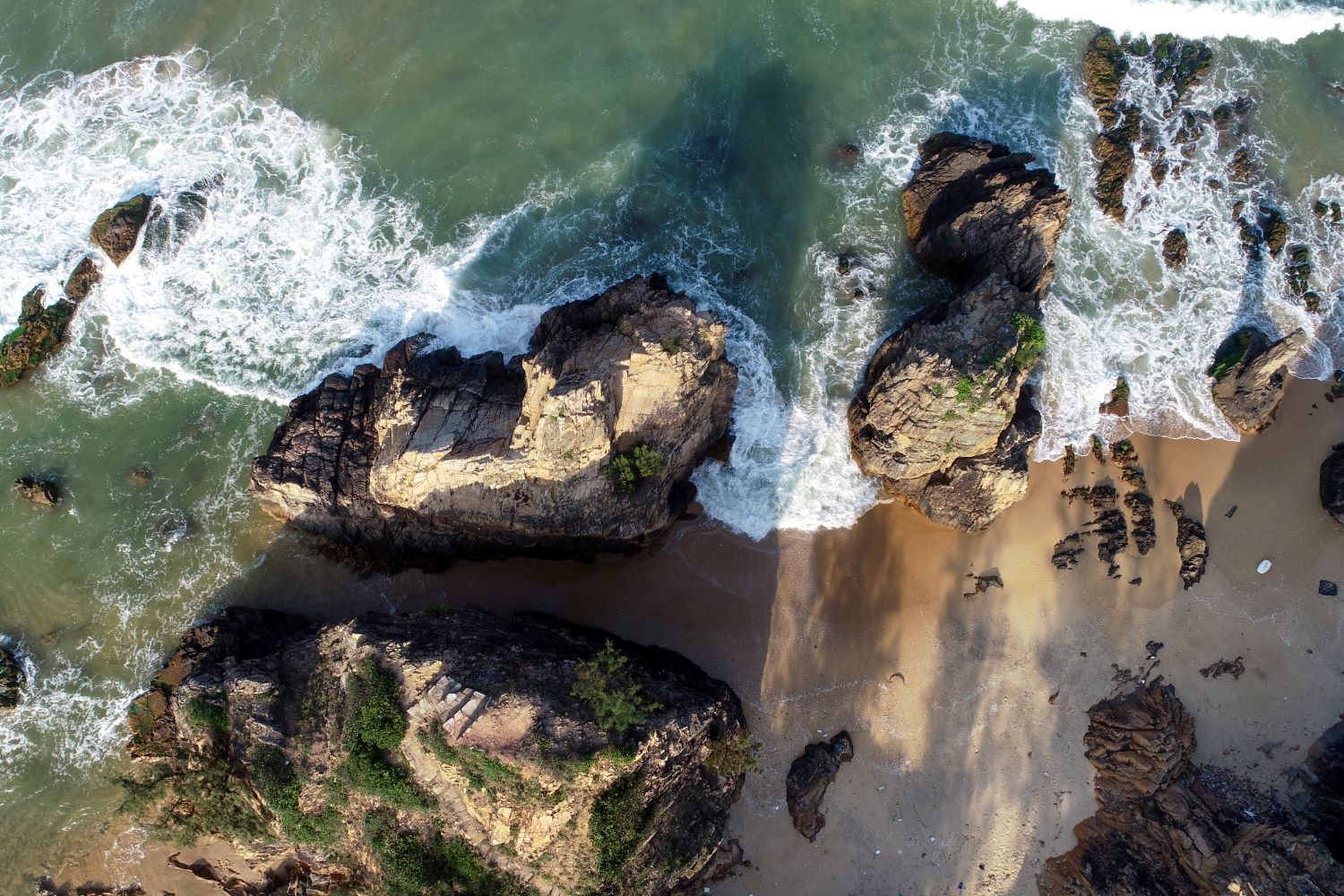
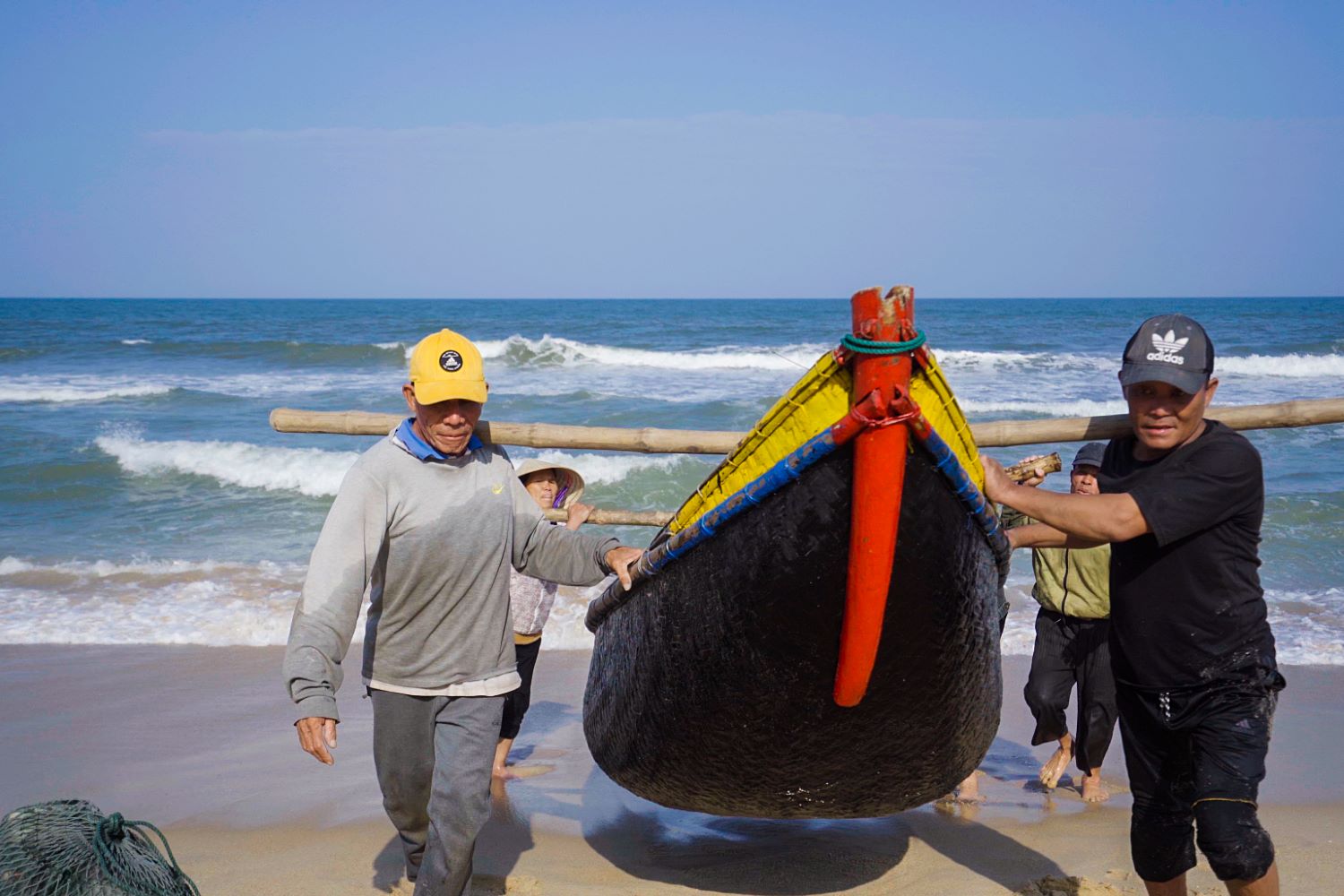
Poison Nose (Guangdong)
Located under the sunshine of the Central region, Doc Cape – located in Quang Dong commune, Quang Trach district, Quang Binh province, has long attracted tourists because of the wild and majestic beauty of nature. Among the places in Vietnam known as “virtual living rocks” such as Pha Luong peak (Son La), Ta Xua turtle head (Yen Bai), and Lao Than peak (Lao Cai), Doc Cape stands out with difference. At Doc Cape, you can not only experience watching the “sea of clouds” but also immerse yourself in the wonderful beauty of the lush green beach.
To get to Doc Cape from Vung Chua – Yen Island, starting at Vung Chua – Yen Island, Quang Dong, Quang Binh, you head west on the road to the mausoleum. During the journey, you will pass the Vung Chua Security Team on the right side, about 750m away. Continue moving for about 1.5 km, then turn right at the intersection and follow Hon La Economic Zone Executive House road on the right, continue moving about 3.6 km and turn left at the intersection according to. Your destination will be on the left side.
The beach at Doc Cape is a special spot that captivates visitors. Smooth white sand stretches along the blue beach, creating a beautiful dream-like picture. This is a great place to swim, relax, and start the day with a walk on the sand. Natural rock formations formed from ocean waves and high tides are a unique highlight at Doc Cape. The long row of rocks running to the sea creates an interesting space and is the perfect location for those who love “virtual living” photos. From Doc Cape, you will admire Yen Island, another famous destination of Quang Binh.
The best time to visit Doc Cape is from April to September. The best choice to visit Doc Cape is when the weather is warm and the sea is calm. To watch the first rays of sunlight appear, the scenery here becomes magical and creates a beautiful relaxing space, you should try to come here early in the morning to catch the sunrise.
While visiting and having fun, make sure you preserve natural beauty by keeping trash in the right place and respecting the surrounding environment. At the same time, when visiting the rocks, be careful to avoid danger. When you come to Doc Cape, you will enjoy the wild and natural beauty in one of the most beautiful spots in Quang Binh.
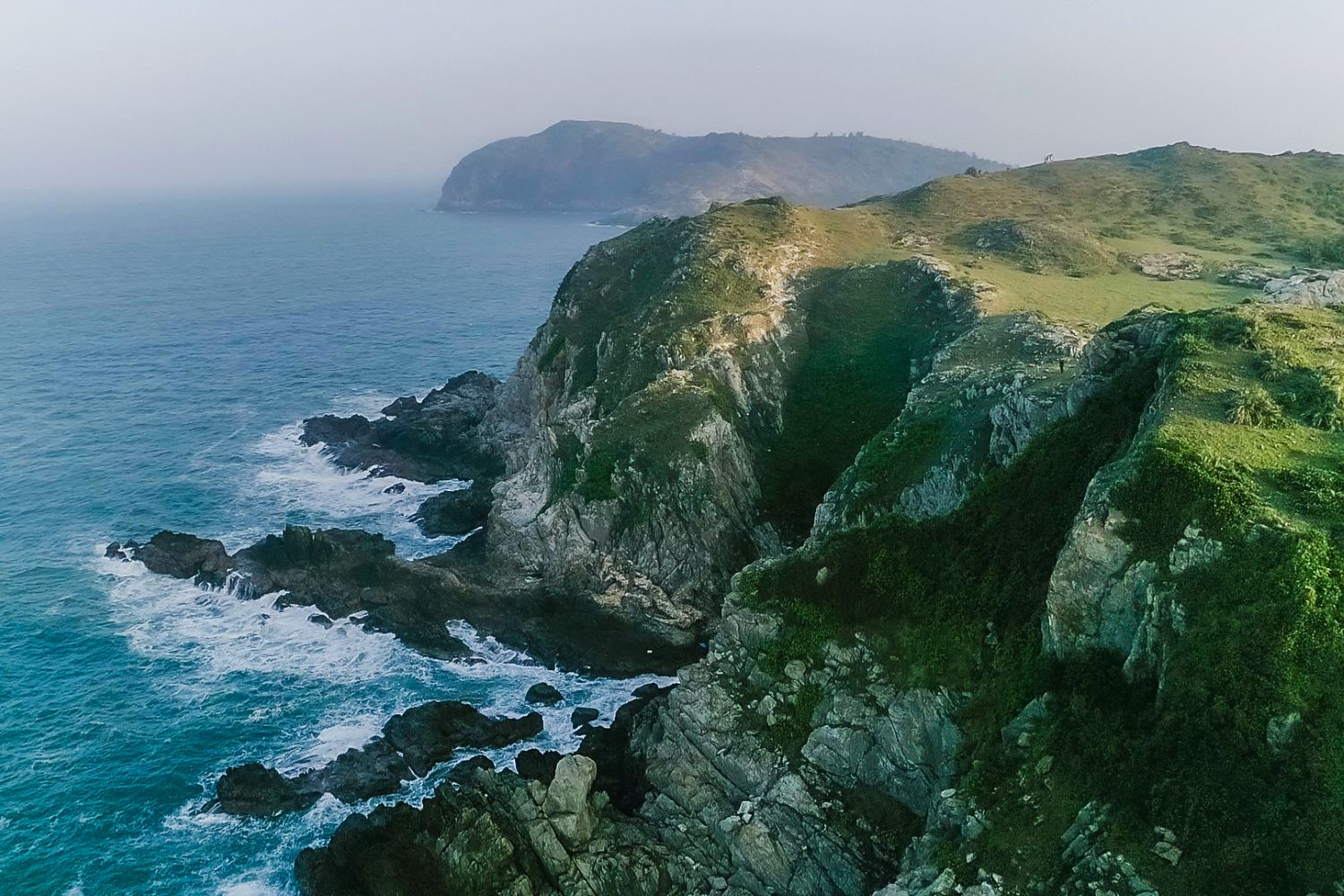
Wind Island (Bird Island)
Hon Gio, often called Bird Island or sometimes Wind Island, is a wonderful destination located in Quang Binh, a province in Central Vietnam. This island is known for its wild beauty, beautiful nature and diversity of rare birds.
Bird Island is located about 70km north of Dong Hoi city center. To get to the island, the journey usually starts from Nhat Le beach – one of the notable spots in Quang Binh. From here, visitors need to take a boat trip about 4 hours long to reach Hon Gio. If you want a shorter journey, you can choose the route from Canh Duong estuary, which only takes about 2 hours.
With an area of more than 1 square kilometer, Bird Island is truly a pristine gem of nature, with long stretches of sand, sloping limestone cliffs and lush green beaches. But the special thing is that Bird Island is home to many rare bird species. You can see seagulls, swifts, swallows and many other birds immersing themselves in the beautiful natural landscape. With the blue of the sea water and the green of the trees on the island, Hon Gio creates a harmonious and attractive picture.
From the height of the rocks on the island, visitors can enjoy a vast view, with the vast ocean stretching before their eyes. The sound of ocean waves hitting the cliffs, along with the songs of the island’s birds, create a unique natural concert, making the experience even more wonderful.
Bird Island is kept pristine, untouched by human intervention. This makes the island the perfect destination for those who want to get away from urban life and seek peace in nature. Not only does it have beautiful landscapes, Hon Gio also has a fresh environment, cool climate and many unique and attractive tourist destinations. When visiting Hon Gio, visitors also have the opportunity to explore other islands in the area such as Yen Island and Hang Doi, creating a diverse and interesting travel experience in the beautiful land of Quang Binh.
From historic cultural relics to fresh seascapes, Quang Trach is striving to take advantage of its unique natural and cultural resources to create an attractive tourist destination. With a combination of determination to develop and honor local values, Quang Trach is shaping up to become a diverse tourist destination, where visitors will not only discover its natural beauties but also its unique qualities. unique cultural flowers of this land. The harmony between nature and people in Quang Trach promises to bring memorable travel experiences and leave a mark in the hearts of every visitor.


Frequently asked questions
When is the best time to travel to Quang Trach?
The best time to travel to Quang Trach, Quang Binh, is usually between January and September. During this period, Quang Binh experiences the dry season with warm weather and little rain, creating favorable conditions. Beneficial for sightseeing and enjoying outdoor activities such as sightseeing, exploring, and sightseeing. Besides, if you want to participate in the festival, pay attention to the time held at the destination to arrange a suitable schedule.
What is the means of transportation to Quang Trach?
Quang Trach is a district in Quang Binh province, about 30km from Dong Hoi city center. There are many means of transportation to Quang Trach, including:
- Bus: You can buy bus tickets at bus stations in Hanoi, Da Nang, Hue,… to go to Dong Hoi.
- Train: Train is a safe and comfortable means of transportation to Dong Hoi station. You can buy train tickets at train stations in Hanoi, Da Nang, Hue,… to get here.
- Airplane: Airplane is the fastest means of travel to Quang Trach. You can buy plane tickets at domestic airlines to go to Dong Hoi airport.
- Motorbike: You can also drive your motorbike to Quang Trach to experience a new and interesting trip.
After arriving in Dong Hoi, you can travel by taxi or bus to Quang Trach.
What specialties does Quang Trach have that you should try?
In Quang Trach, visitors can enjoy many delicious and unique specialties. Some famous specialties here include Tan An sesame rice paper, brown rice pancakes and fresh seafood dishes such as scallops, squid, shrimp, and sea fish,… Visitors can find restaurants local restaurants to experience the special flavors of Quang Trach coastal area.
Are there any special festivals and events taking place in Quang Trach?
In Quang Trach, one of the famous special festivals and events is “Quang Binh Cau Ngu Festival.” This festival takes place in the districts of Quang Trach, Bo Trach, Quang Ninh, Le Thuy, Ba Don town and Dong Hoi city, Quang Binh province. Usually held in the first lunar month, Cau Ngu festival has the meaning of remembering the virtues of sea gods such as Ong fish and Ba fish. People celebrate this festival with the hope that the sea will be peaceful, the weather will be cool, and there will be many fish and shrimp. Cau Ngu Festival also represents the wish for a prosperous fishing season, a peaceful life, and harmony for both nature and people. This is an important traditional event marking the cultural and spiritual beauty of the people of Quang Trach.
How to book hotel or accommodation in Quang Trach?
To book hotels or accommodation in Quang Trach, you can also contact hotels or motels in Quang Trach directly to book rooms. Some popular hotels and motels include: Green Hotel, Linh Giang hotel, Co Huong hotel, Bao Hung motel, Yen Dung motel,… Besides, visitors can rent motorbikes/taxi Explore during the day and return to Dong Hoi to enjoy the cuisine and vibrant nightlife instead of staying overnight in Quang Trach.
What are the most famous tourist destinations that tourists should not miss in Quang Trach?
Famous tourist destinations in Quang Trach that tourists should not miss include Canh Duong mural village with unique mural art, Quang Trach coastal villages to explore its natural beauty and traditional culture. special and participate in Cau Ngu festival. If you want to combine visiting natural landscapes with spiritual tourism, you can visit Vung Chua – Yen Island – the resting place of General Vo Nguyen Giap. In addition, Tan An rice paper village is also an interesting place, where you can participate in the traditional rice paper making process and enjoy unique local specialties.